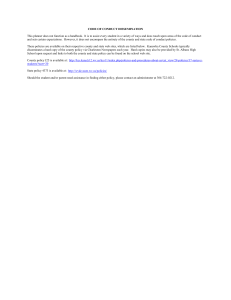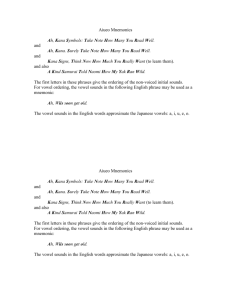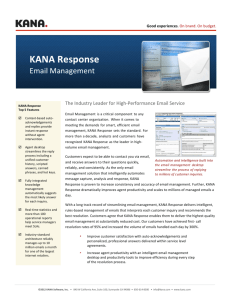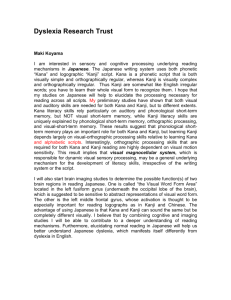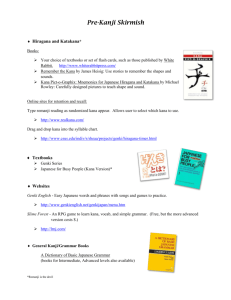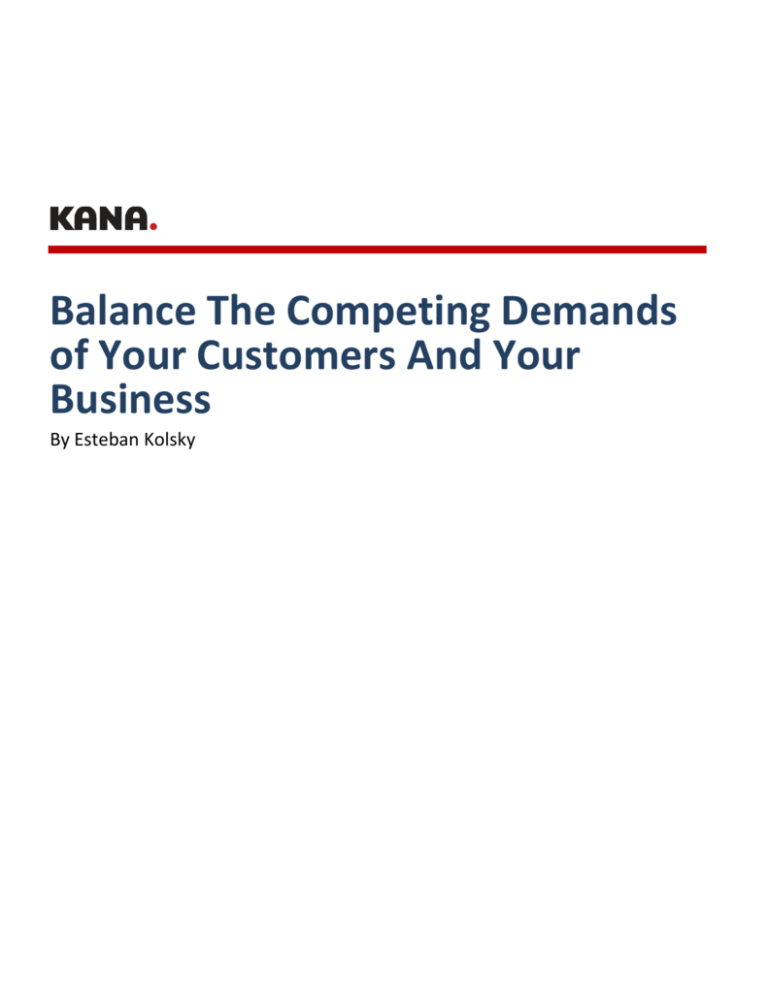
Balance The Competing Demands
of Your Customers And Your
Business
By Esteban Kolsky
Good experiences. On brand. On budget.
Table of Contents
Executive Summary .................................................................................................................................................................................3
Introduction ............................................................................................................................................................................................4
The Growing Demands on Customer Service .........................................................................................................................................4
The Balancing Act in Customer Service ...................................................................................................................................................5
In Search of a New Customer Service Model ..........................................................................................................................................6
The Return of the Customer Service Mashup .........................................................................................................................................7
Three Action Items to Start .....................................................................................................................................................................8
About Esteban Kolsky .............................................................................................................................................................................9
About KANA ............................................................................................................................................................................................9
©2011 KANA Software, Inc. • 840 W California Ave, Ste 100, Sunnyvale CA 94086 • 1.800.737.8738 • sales@kana.com • www.kana.com
PAGE 2
Good experiences. On brand. On budget.
Executive Summary
The hopes of Customer Service have lately been placed on Customer Experiences. As the
theory goes, if you deliver excellent Customer Experiences, they will be satisfied, loyal,
and increase their wallet-share with an organization. Alas, a recent study found that
although 80% of companies believe they are doing an outstanding job in delivering those
excellent experiences, just 8% of their customers agree.
The issue has shifted from whether it is the best move to deliver Customer Experiences, to
how to do a better job. Organizations that want to improve the experiences they deliver
must reach a balance between serving the needs of their organization, and meeting the
expectations from their customers – all at the same time.
To deliver in this need, organizations are realizing that even though it is not all about
technology, it does play a significant role; existing technology is not ready to deliver. The
question is not whether technology refresh is a necessity, which it is, but how to create a
better architecture to support the business needs.
Striving to create and deliver better experiences will necessitate two things to work
jointly: a new architecture to support a distributed execution model that leverages past
investments and the necessary changes in measurement, governance, people, and nontechnical processes to accommodate the new reality.
Organizations that act on this new model will experience better tracking of metrics and
measurement, optimized leverage of existing investments, and stands ready to take their
Customer Service model to the next generation – cross-channel Customer Service focused
on delivering excellent experiences.
©2011 KANA Software, Inc. • 840 W California Ave, Ste 100, Sunnyvale CA 94086 • 1.800.737.8738 • sales@kana.com • www.kana.com
PAGE 3
Good experiences. On brand. On budget.
Introduction
According to a study by Bain and company, 80% of organizations think they have done a
great job of providing good experiences for their customers. The problem is that only 8%
of their customers agree. In other words, either companies don’t know what their
customers want, or don’t know how to deliver it.
Having spent many years working with organizations of all sizes, I am going to side with
the second option: organizations are having a hard time delivering to their clients’ needs
and demands.
And, it is about to get worse.
The Growing Demands on Customer Service
Customer Service has traditionally been the function that remains in closer contact with
the customer. In some industries, over 90% of all interactions happen via Customer
Service. They are the front-line
of the relationship, and in most
cases they retain command and
control of how that interaction
flows.
Demands on Customer Service
are nothing new; they have
always been the recipients of
multiple requests from myriad
sources: business stakeholders
within the organization expect
them to deliver customer data,
insights, and information derived from those interactions, customers expect them to
deliver against their needs, wants, and desires, and management expect them to always
deliver more with ever-dwindling resources.
Lately, though, it seems that those demands have become better tuned to delivering
value – to all involved parties – and this is an area where Customer Service solution
providers can add value.
The expectations for Customer Service to deliver value are centered on six areas:
1.
Technology Refresh – Every so often, usually when new tools and technologies reach
critical mass, customer service solutions will get a face-lift, a technology refresh. This
is a good time to catch up on the latest improvements, implement new features and
channels, and conduct an audit of where Customer Service is and where it needs to
be. Due to the sudden and expedient rush to Social Media and Customer Experiences
in the past two-three years, the time for the technology refresh is now. That means
that customer service organizations are evaluating their existing solutions and what’s
available, making decisions on how to change their customer service model.
©2011 KANA Software, Inc. • 840 W California Ave, Ste 100, Sunnyvale CA 94086 • 1.800.737.8738 • sales@kana.com • www.kana.com
PAGE 4
Good experiences. On brand. On budget.
2.
Shifting Channels – Channels are poorly understood, to say the least, by most
customer service organizations. There are many who believe they are all very different
and must operate separately, while the modern view of the contact center talks to
integrated, centralized channel management and architecture. The move to
accommodate the new channels while still supporting the old ones – without
forgetting that they all must operate equally puts a lot of pressure on customer
service organization without a clear solution.
3.
Leverage – Virtually all components of a customer service center (whether call center
or contact center) have already been implemented. Some of them – actually a lot of
them – more than once. It is now time to begin to consolidate and leverage them as
new channels, solutions, and models are deployed. Pressure rises on Customer Service
organizations to consolidate and reuse existing modules.
4.
Innovation – Even though technology and tools are being refreshed and reused,
innovation in Customer Service is almost non-existent. The traditional model for
interacting with customers, regardless of channels, remains the same as it always
was. This lack of innovation in how to do customer service leads to innovation on
how to do it better – more efficiently, more effectively, faster, cheaper, and
easier. It is this process innovation that will lead Customer Service forward in the
next twelve months.
5.
Voice of the Customer - The customer has risen! Whether via social channels or
traditional channels, the customer today is more vociferous than at virtually any other
time in the past. This change is not only about expressing their views, opinions, and
feedback – but also demanding that it is used, that changes take place, and that
processes be improved to serve their needs, not the organizations’.
6.
Customer Experiences - Finally, the movement that has been pushing change in
Customer Service for the past four-to-seven years: focusing on delivering better
experiences for the customer. The change from interaction-centric behaviors to
experience-based behaviors (both for the customer and the organization) brings heavy
demands to create and constantly improve the previously-deployed interactions as
experiences.
As you can see, not all of these demands are contradictory to each other – actually, a
set of common requirements emerge, urging a new way to manage customer service.
The Balancing Act in Customer Service
This is where it gets interesting, actually. Customers want a simpler, better, faster model
for Customer Service that will allow them to interact through any channel, in their
preferred manner of behavior, to complete their jobs. Organizations want to deliver
simpler, faster, better Customer Service solutions to reduce the costs and bother of
running customer service.
The balancing act of making both happen at the same time is the job of the VP of
Customer Service or Customer Service Manager.
This individual must consider the many cogs in the Customer Service wheel and make
sure they all operate together, well enough, and with the minimum disruption to the
business operations – while keeping in mind the three critical aspects of delivering
Customer Service solutions:
©2011 KANA Software, Inc. • 840 W California Ave, Ste 100, Sunnyvale CA 94086 • 1.800.737.8738 • sales@kana.com • www.kana.com
PAGE 5
Good experiences. On brand. On budget.
Business Demands – The
demands highlighted in
the
above
section
influence the direction
that Customer Service
takes and how the cogs in
the wheel work together.
The Customer Service
Manager must consider all
of the above demands
while remaining focused
on how to deliver the best
possible solution – not an
easy task in complex
enterprises with highly
charged political and
economical considerations.
Resources – Of course, delivering on demands is simple with unlimited resources (budget,
time, technology, channels, governance support, etc.), but this is never the case in any
organization. The very limited set of resources available to the Customer Service Manager
makes it virtually impossible to deliver a balanced experience for organization and customers.
As an example, a change in regulations requires customer service to adapt to new rules and
behaviors with the same employees and systems as before – not very easy to do.
Employees – The most critical cog in the wheel, and the most susceptible to break down.
While technologies are replaceable, employees are not so easy to replace – at least not
properly trained and with adequate talents. Carefully considering the needs and demands of
the employees, and countering those with the business demands and available resources is
how a Customer Service solution is created. Empowering the employees to make some of the
decisions previously made by the Customer Service Manager – in real time – is the latest trick
to make the solution work better.
In Search of a New Customer Service Model
The balance between providing a Customer Service solution that fulfills the needs of the
organization, while keeping the demands and expectations of the customer at the same time
has its apogee in a customer-centric model. A win-win model where the focus is on the
customer needs and the organization’s wants at the same time, a customer-centric model is
focused on making sure that customers’ expectations are met while maintaining a financial,
regulatory, and governance view of the organization’s ability to deliver at the forefront.
A customer-centric model is not a new concept. What’s new is the availability of feedback
from customers (in form of unstructured feedback) in massive volumes, and the flexibility of
tools and technologies to morph to those shifting needs and desires in real-time – while
©2011 KANA Software, Inc. • 840 W California Ave, Ste 100, Sunnyvale CA 94086 • 1.800.737.8738 • sales@kana.com • www.kana.com
PAGE 6
Good experiences. On brand. On budget.
maintaining sufficient control of
the outcomes to incorporate into
the corporate strategies, goals,
and objectives is something we
are just beginning to observe and
experience.
Coupling the building of these
awesome experiences with the
new architecture necessary to
support the above demands and objectives is imperative for Customer Service organizations –
especially those that are embarked in customer-centricity or customer-experience initiatives.
To make all this happen, the traditional model of delivering customer service in a static
manner – that is build a process, implement it, and change it little or nothing – is not viable.
Organizations embarking on this change to become more customer centric, to deliver better
against their needs and their customers desires, and who want to focus on awesome
experiences need to leverage a new model of Customer Service – one that we have seen
before, but were not able to implement from lack of the right components.
The Emergence of Customer Sevice Process Mashups
Mashups have existed for a while. IT organizations have deployed them, successfully, to
consolidate access to tools. With Mashups, instead of hunting and pecking, agents can
access all their tools in a single place. Great. But mashups have failed to help the agents
and guide them through the best process of completing a task. In other words, a
traditional mashup is like toolbox – everything is in place and easily accessible. But a toll
box does tell the user which tool to use and how for a particular task.
Thus, we are seeing an emergence towards a flexible architecture with many little pieces
capable of completing a single task or assisting in completing complex tasks as well. The
concept of a process mashup, gathering the necessary technologies and tools from myriad
available ones, and build a specific-purpose-style mini-application to do what is necessary
– while leveraging existing systems and components, is making a return appearance.
Laughed out of the enterprise due to the complexity of deployment and management,
traditional mashups have gotten smarter in the past few years. It is no longer a
requirement to have a complex development cycle – rather to know how to leverage
existing platforms and components into building new functionality from them. Knowing
what is the end-goal of any interaction, what platforms provide elements or components
that may help, what tools and technologies exist to help – and how to implement it and
make it work are the staples of today’s process mashups.
©2011 KANA Software, Inc. • 840 W California Ave, Ste 100, Sunnyvale CA 94086 • 1.800.737.8738 • sales@kana.com • www.kana.com
PAGE 7
Good experiences. On brand. On budget.
Customer Service is being reinvented as a series of highly specialized, highly flexible, well
integrated process mashups that leverage systems, tools, technologies and (more
importantly) existing and new data. In this new model it is very simple to deploy a new
channel, accommodate a change in legislation or regulations, or even change the way a
process is executed. Being able to change the code in a simple, small component instead
of an entire software package is critical for the Customer Service Manager to deliver the
best working wheel, to accommodate the demands from the business, and to meet or
exceed the expectations of customers.
Three Action Items to Start
Adopting such architecture is not an overnight task, nor is something that can be totally
planned ahead of time. Changes to the strategy and adoption plans are going to be
necessary as it progresses. However, there are three key actions any organization can take
to be ready for them:
1.
Focus on the Architecture – A quintessential component of this architecture is the
flexibility and dynamicity it presents to connect all components and modules, while
allowing for easy leverage of what was already created. To support this flexibility,
proprietary and cumbersome integration layers and connectivity, as traditionally
required by end-to-end integration architectures, cannot be used. The best platform
to use is one that supports SOA (Service Oriented Architecture), and any organization
that is planning on moving towards mashups to deploy Customer Service must
consider the standard as a way to create and deploy rapidly and simply.
2.
Operational Efficiencies – Implementing Customer Service process mashups will bring
Operational Efficiencies, mostly from being able to re-create similar processes in
different channels, react to changes very fast, even from integrating disparate systems
into one common interface without much trouble. Alas, these operational efficiencies
are usually not sought – rather experienced as an after fact. World class organizations
will indeed seek those operational efficiencies as part of the planning process for
©2011 KANA Software, Inc. • 840 W California Ave, Ste 100, Sunnyvale CA 94086 • 1.800.737.8738 • sales@kana.com • www.kana.com
PAGE 8
Good experiences. On brand. On budget.
mashups. Probably not before the first ones, but as soon as they realize what they
stand to gain – they will definitely do so. Especially as they have acquisitions, or bring
in new functionality to leverage existing operational efficiencies.
3.
Tracking - As mentioned above, one of the pressures of moving to this new
architecture is the migration from single-channel to multi-channel to cross-channel.
This migration brings with it the added pressure of having to monitor and track all
interactions across all channels – even report one interaction that starts in one
channel and ends in another. The mashup architecture as described above makes it
easier (the solution still relies on a proper cross-channel measurement strategy; this
architecture simply provides the framework to make that happen). Knowing that you
can now track, monitor, and measure metrics across channels and interactions is a
benefit that should make it easier and better to plan for the deployment of those
measurement strategies.
About Esteban Kolsky
Esteban Kolsky is the Principal and Founder of ThinkJar, an advisory and research thinktank focused on Customer Strategies. He has over 22 years of experience in customer
service and CRM consulting, research, and advisory services. Most recently he spent eight
years at Gartner, focused on Customer Service and CRM research. While there he coined
the terms for EFM (enterprise feedback management)
and CIH (customer interaction hub). In addition, he
researched and wrote on the social networking topics
that led to today’s revolution and assisted Fortune 500
and Global 2,000 organizations in all aspects of their
CRM deployments. Mr. Kolsky is currently advising
vendors and organization how to extend customer
interactions from the CRM niche to the entire
organization in their efforts to become Social
Businesses.
About KANA Service Experience Management
KANA SEM is the industry’s first service experience management (SEM) platform for
managing the entire customer service experience. KANA’s SEM platform helps major
corporations and institutions balance the demands of their business with the needs of the
customer.
©2011 KANA Software, Inc. • 840 W California Ave, Ste 100, Sunnyvale CA 94086 • 1.800.737.8738 • sales@kana.com • www.kana.com
PAGE 9
Good experiences. On brand. On budget.
KANA SEM introduces the industry’s first platform that incorporates a Design-OrchestrateListen methodology which enables corporations to provide cross-channel contextual
support built on the foundation of knowledge infused customer service processes.
KANA SEM integrates IBM Information Management® and IBM WebSphere® products into
the solution to deliver a high performing, reliable solution out of the box.
To learn more about Service Experience Management and how KANA can help you
balance the competing demands of your customers and business, please call us at 1-800737-8738 or visit our website at www.kana.com.
Copyright 2011 KANA Software, Inc. KANA and the KANA logo are registered trademarks of KANA.
Other company, product and service names may be service marks of their respective owners.
840 W California Avenue, Suite 100
Sunnyvale, CA 94086
T 650.614.8300 | F 408.736.7613
www.kana.com
Contact us at http://www.kana.com/contact-us/contactsem.php
Twitter @KANASoftware
Linkedin: http://www.linkedin.com/groups/KANA-Software-1129?mostPopular=&gid=1129
Facebook: https://www.facebook.com/pages/KANA-Software-Inc/146154198748782
All Rights Reserved. 0110-01
©2011 KANA Software, Inc. • 840 W California Ave, Ste 100, Sunnyvale CA 94086 • 1.800.737.8738 • sales@kana.com • www.kana.com
PAGE 10

